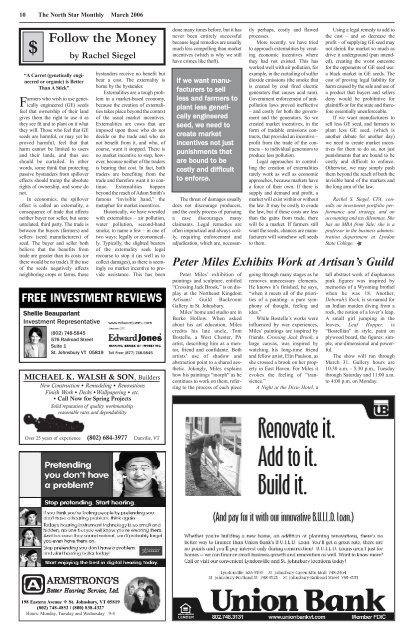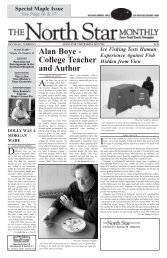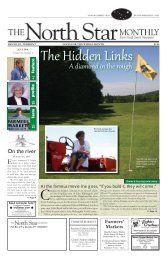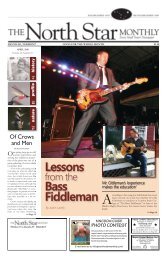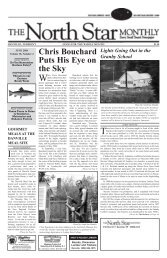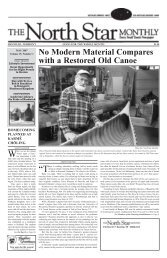March - The North Star Monthly
March - The North Star Monthly
March - The North Star Monthly
Create successful ePaper yourself
Turn your PDF publications into a flip-book with our unique Google optimized e-Paper software.
10 <strong>The</strong> north <strong>Star</strong> <strong>Monthly</strong> <strong>March</strong> 2006$Follow the Money“a carrot (genetically engineeredor organic) is BetterThan a Stick”Farmers who wish to use geneticallyengineered (GE) seedsfeel that ownership of their landgives them the right to use it asthey see fit and to plant on it whatthey will. Those who feel that GEseeds are harmful, or may yet beproved harmful, feel that thatharm cannot be limited to usersand their lands, and thus useshould be curtailed. In otherwords, some think that protectingpassive bystanders from spillovereffects should trump the absoluterights of ownership, and some donot.In economics, the spillovereffect is called an externality, aconsequence of trade that affectsneither buyer nor seller, but someunrelated, third party. <strong>The</strong> trade isbetween the buyers (farmers) andsellers (seed manufacturers) ofseed. <strong>The</strong> buyer and seller bothbelieve that the benefits fromtrade are greater than its costs (orthere would be no trade). If the useof the seeds negatively affectsneighboring crops or farms, thoseShellie BeauparlantInvestment Representativeby Rachel Siegelbystanders receive no benefit butbear a cost. <strong>The</strong> externality isborne by the bystander.Externalities are a tough problemin a market-based economy,because the creation of externalitiestakes place beyond the contextof the usual market incentives.Externalities are costs that areimposed upon those who do notdecide on the trade and who donot benefit from it, and who, ofcourse, want it stopped. <strong>The</strong>re isno market incentive to stop, however,because neither of the tradersis bearing that cost. In fact, bothtraders are benefiting from thetrade and therefore want it to continue.Externalities happenbeyond the reach of Adam Smith’sfamous “invisible hand,” themetaphor for market incentives.Historically, we have wrestledwith externalities – air pollution,water pollution, second-handsmoke, to name a few – in one oftwo ways: legally or economically.Typically, the slighted bearersof the externality seek legalrecourse to stop it (as well as tocollect damages), as there is seeminglyno market incentive to provideassistance. This has been(802) 748-5845576 Railroad StreetSuite 1St. Johnsbury VT 05819 Toll Free: (877) 748-5845MICHAEL K. WALSH & SON, BuildersNew Construction w Remodeling w RenovationsFinish Work w Decks wWallpapering w etc.w Call Now for Spring ProjectsSolid reputation of quality workmanship,reasonable rates and dependabilitydone many times before, but it hasnever been entirely successfulbecause legal remedies are usuallymuch less compelling than marketincentives (which is why we stillhave crimes like theft).If we want manufacturersto sellless and farmers toplant less geneticallyengineeredseed, we need tocreate marketincentives not justpunishments thatare bound to becostly and difficultto enforce.<strong>The</strong> threat of damages usuallydoes not discourage producers,and the costly process of pursuinga case discourages manyclaimants. Legal remedies areoften impractical and always costly,requiring enforcement andadjudication, which are, necessarilyperhaps, costly and flawedprocesses.More recently, we have triedto approach externalities by creatingeconomic incentives wherethey had not existed. This hasworked well with air pollution, forexample, in the curtailing of sulfurdioxide emissions (the smoke thatis created by coal fired electricgenerators that causes acid rain).Government enforcement of antipollutionlaws proved ineffective– and costly for both the governmentand the generators. So wecreated market incentives, in theform of tradable emissions contracts,that provided an incentive –profit from the trade of the contracts– to individual generators toproduce less pollution.Legal approaches to controllingthe creation of externalitiesrarely work as well as economicapproaches, because markets havea force of their own. If there issupply and demand and profit, amarket will exist within or withoutthe law. It may be costly to evadethe law, but if those costs are lessthan the gains from trade, therewill be a market. If farmers stillwant the seeds, chances are manufacturerswill somehow sell seedsto them.Using a legal remedy to add tothe cost – and so decrease theprofit – of supplying GE seed maynot shrink the market so much asdrive it underground (pun intended),creating the worst outcomefor the opponents of GE seed use:a black market in GE seeds. <strong>The</strong>cost of proving legal liability forharm caused by the sale and use ofa product that buyers and sellersdeny would be prohibitive forplaintiffs or for the state and thereforeessentially unenforceable.If we want manufacturers tosell less GE seed, and farmers toplant less GE seed, (which isanother debate for another day)we need to create market incentivesfor them to do so, not justpunishments that are bound to becostly and difficult to enforce.Otherwise, we may simply pushthem beyond the reach of both theinvisible hand of the markets andthe long arm of the law.rachel S. Siegel, CFA, consultson investment portfolio performanceand strategy, and onaccounting and tax dilemmas. Shehas an MBA from Yale; she is aprofessor in the business administrationdepartment at LyndonState College.Peter Miles Exhibits Work at Artisan’s GuildPeter Miles’ exhibition ofpaintings and sculpture, entitled“Crossing Jack Brook,” is on displayat the <strong>North</strong>east KingdomArtisans’ Guild BackroomGallery in St. Johnsbury.Miles’ home and studio are inBurke Hollow. When askedabout his art education, Milescredits his late uncle, TomBostelle, a West Chester, PAartist, describing him as a mentor,friend and confidante. Bothartists’ use of shadow andabstraction point to a shared aesthetic.Jokingly, Miles explainshow his paintings “morph” as hecontinues to work on them, referringto the process of each piecegoing through many stages as heremoves unnecessary elements.He knows it’s finished, he says,“when it meets all of the prioritiesof a painting- a pure symphonyof thought, feeling andidea.”While Bostelle’s works wereinfluenced by war experiences,Miles’ paintings are inspired byfriends. Crossing Jack Brook, alarge canvas, was inspired bywatching his long-time friendand fellow artist, Elin Paulson, asshe crossed a brook on her propertyin East Haven. For Miles itevokes the feeling of “transience.”A Night at the dixie Hotel, atall abstract work of diaphanouspink figures was inspired bymemories of a Wyoming brothelwhen he was 18. Another,deborah’s rock, is so-named foran Indian maiden diving from arock, the notion of a lover’s leap.A small girl jumping in theleaves, Leaf Hopper, is“Bostellian” in style, paint onplywood board, the figures: simple,one-dimensional and powerful.<strong>The</strong> show will run through<strong>March</strong> 31. Gallery hours are10:30 a.m. - 5:30 p.m., Tuesdaythrough Saturday and 11:00 a.m.to 4:00 p.m. on Monday.Over 25 years of experience (802) 684-3977 Danville, VT198 Eastern Avenue v St. Johnsbury, vT 05819(802) 748-4852 / (800) 838-4327Hours: Monday, Tuesday and Wednesday 9-4


